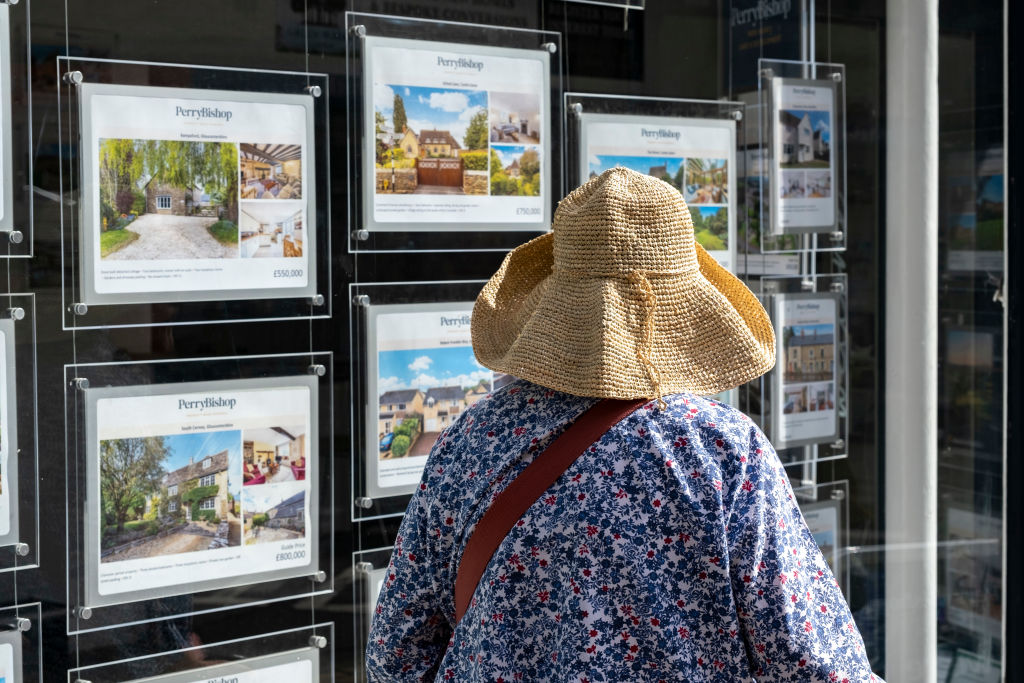How the housing market will look in five years
Savills has revised its five-year house price forecasts while the Land Registry has explained how using better technology will make it easier to buy and sell homes


Marc Shoffman
House price growth is set to be slower this year and next but there are hopes for a recovery between 2027 and 2030, according to Savills.
New five-year house price forecasts from the estate agency brand suggest that average property prices will grow by just 1% this year and by 2% in 2026, down from a previous prediction of 4% growth next year.
Overall, Savills expects UK property prices to grow by 22% on average over the next five years, with northern England, Wales and Scotland set to see the biggest rises.
MoneyWeek
Subscribe to MoneyWeek today and get your first six magazine issues absolutely FREE

Sign up to Money Morning
Don't miss the latest investment and personal finances news, market analysis, plus money-saving tips with our free twice-daily newsletter
Don't miss the latest investment and personal finances news, market analysis, plus money-saving tips with our free twice-daily newsletter
The housing market may look different by 2030 as well, with a new strategy from the Land Registry this week suggesting that more technology and artificial intelligence could improve the way homes are purchased over the next five years.
What is happening with UK house prices?
The average house price in the UK is expected to increase by £80,000 between 2025 and 2030 as interest rates fall and the economic outlook improves, new research suggests.
According to Savills, property values will rise modestly across 2026, before picking up the following year and continuing the positive trend.
Yorkshire and The Humber, North East England, Scotland, Wales and North West England will see the biggest appreciation – upwards of 27.5% – the estate agency said.
London and South East England will likely see the lowest house price growth over the next five years.
Property values there will increase by a more paltry 17% by 2030, Savills predicted.
The rise in house prices is expected following slower house price growth in 2025, due to weaker consumer sentiment, concerns over the economy and lower demand, as well as worries over what might be announced in the Autumn Budget in November.
House prices have risen by just 0.5% so far this year, according to Nationwide Building Society.
Savills forecasts the Bank of England (BoE) base rate will fall to 2.5% by 2030, from 4% currently.
Further cuts will also be supported by the relaxation of mortgage rules earlier this year which mean lenders can issue more potentially riskier home loans.
Meanwhile, beyond 2026, the UK economy is expected to be stronger, with lower inflation, rising GDP growth, falling unemployment and an undersupply of new homes which will maintain “upwards pressure” on prices.
| 2025 | 2026 | 2027 | 2028 | 2029 | 2030 | Total growth |
Average UK price growth (%) | 1.0% | 2.0% | 4.0% | 5.0% | 5.5% | 4.0% | 22.2% |
Average UK house price (£) | £359,875 | £367,073 | £381,756 | £400,844 | £422,890 | £439,806 | £79,930 |
Transactions | 1,175,000 | 1,150,000 | 1,170,000 | 1,175,000 | 1,180,000 | 1,190,000 | - |
Base rate (year-end) | 4.00% | 3.50% | 3.00% | 2.75% | 2.50% | 2.50% | - |
CPI inflation (year-end) | 3.8% | 2.6% | 2.3% | 2.1% | 2.1% | 2.0% | 11.6% |
Nominal income growth | 3.3% | 2.4% | 2.4% | 3.4% | 3.2% | 2.9% | 15.3% |
Real GDP growth | 1.4% | 1.0% | 1.5% | 1.8% | 1.6% | 1.6% | 7.7% |
Where are house prices set to grow the most in Britain?
Across the mainstream market, Yorkshire and The Humber and North East England are expected to see the biggest house price growth between 2025 and 2030, with property values surging by 28.8% there.
Meanwhile, prices are forecast to rise by 27.6% in Scotland, Wales and North West England. The West Midlands and East Midlands are expected to see 24.6% and 24% increases, respectively.
Savills said it anticipates affordability will be the biggest driver of house price growth in these areas, with London and South East England having less room to see growth as prices there are already so high in comparison to the rest of Britain.
Dan Hill, research analyst at Savills, said: “Regional performance is largely influenced by where we are in the housing market cycle.
“Since 2016, we’ve been in the second half of the cycle, where the more affordable regions in the north and Scotland outperform the UK average, and capacity for growth in London and the south is more limited.
“In the absence of any whole market price correction, this pattern is likely to persist for the next five years, with the strongest growth shifting to late-stage markets in the North East, Scotland & Wales.”
By 2030, Savills forecasts house values in the North West to sit just 15% below the UK average, narrowing from almost 30% in 2020.
Meanwhile, London prices are set to be 33% above the average – down from 70% in 2017.
Region | 2026 | 2027 | 2028 | 2029 | 2030 | 5 years to 2030 |
Yorkshire and The Humber | 3.5% | 5.5% | 6.0% | 6.0% | 5.0% | 28.8% |
North East | 3.5% | 5.5% | 6.0% | 6.0% | 5.0% | 28.8% |
Scotland | 3.0% | 5.0% | 6.0% | 6.0% | 5.0% | 27.6% |
Wales | 3.0% | 5.0% | 6.0% | 6.0% | 5.0% | 27.6% |
North West | 3.0% | 5.5% | 6.0% | 6.0% | 4.5% | 27.6% |
West Midlands | 2.5% | 4.5% | 5.5% | 6.0% | 4.0% | 24.6% |
East Midlands | 2.5% | 4.0% | 5.5% | 6.0% | 4.0% | 24.0% |
UK | 2.0% | 4.0% | 5.0% | 5.5% | 4.0% | 22.2% |
South West | 2.0% | 4.0% | 5.0% | 5.0% | 3.5% | 21.0% |
East of England | 1.5% | 3.5% | 4.5% | 5.0% | 3.5% | 19.3% |
South East | 1.0% | 3.0% | 4.0% | 4.5% | 3.5% | 17.0% |
London | 0.0% | 2.0% | 3.5% | 4.5% | 3.0% | 13.6% |
First-time buyers expected to drive market activity
Savills said increased housing affordability across Britain will drive transaction numbers over the next five years, and close to pre-pandemic averages.
According to the estate agency, the number of completed housing transactions in August was 10% below the 2017-2019 level.
Activity fell sharply but briefly during the pandemic, but rose when the property market reopened and the stamp duty holiday was introduced in summer of 2020.
However, high inflation, rising interest rates and the end of the stamp duty holiday after this led to a reduction in transaction numbers.
Emily Williams, director research at Savills, said: “Housing is technically more accessible now than at any point in the last three years, thanks to lower mortgage rates, lower real house prices and looser mortgage regulation.
“But none of this matters unless buyers feel confident enough to commit – and weaker sentiment is holding back transactions.”
However, weaker sentiment has not hit first-time buyers as much, Savills said, with their purchasing power improving the most.
For second steppers, slower price growth for flats is limiting their ability to move up the ladder in the short term, but mortgaged home movers should drive price growth as interest rates fall.
Meanwhile, buy-to-let transactional activity has been sustained by smaller landlords selling up to larger ones.
This is expected to ramp up now the Renters’ Rights Bill has become law, supported by lower rates and higher rents, although tighter regulation and taxation will limit growth of this sector, it said.
What will the housing market look like in 2030?
It is hard to make housing market predictions as no-one knows what the political and economic environment will be like in 2030.
There may be a new political party in power as well as different geopolitical tensions.
This could mean new policies but one thing political parties of all colours agree on is that the home buying process is too complicated and cumbersome.
Many delays are caused by the time it takes to wait for Land Registry information, which is often still paper-based.
The Land Registry set out a five-year plan this week to use more technology, which it hopes will make it easier to buy and sell homes and reduce fall-throughs.
It has promised that by 2030, the Land Registry it will make its services and information “as easy as possible to access, understand and use” and people will be able to update their own property details by 2035.
The Land Registry also promised to use AI and technology by 2030 to automate as much as possible in the homebuying process and will make all the information it holds accessible online by 2035.
Get the latest financial news, insights and expert analysis from our award-winning MoneyWeek team, to help you understand what really matters when it comes to your finances.

Sam has a background in personal finance writing, having spent more than three years working on the money desk at The Sun.
He has a particular interest and experience covering the housing market, savings and policy.
Sam believes in making personal finance subjects accessible to all, so people can make better decisions with their money.
He studied Hispanic Studies at the University of Nottingham, graduating in 2015.
Outside of work, Sam enjoys reading, cooking, travelling and taking part in the occasional park run!
- Marc ShoffmanContributing editor
-
 High earners face £15k income hit by 2029 following Autumn Budget
High earners face £15k income hit by 2029 following Autumn BudgetRachel Reeves’s Autumn Budget means high earners – or HENRYs – are now looking at an income hit running into the thousands. Can you avoid it?
-
 Millions underestimate how many paydays are left until retirement - why you should be counting your payslips
Millions underestimate how many paydays are left until retirement - why you should be counting your payslipsKeeping track of how long you will be earning a salary for can help work out how much you need to put into a workplace pension